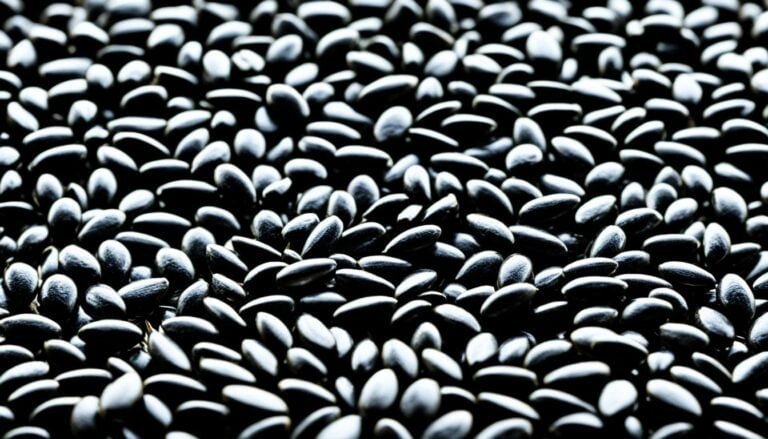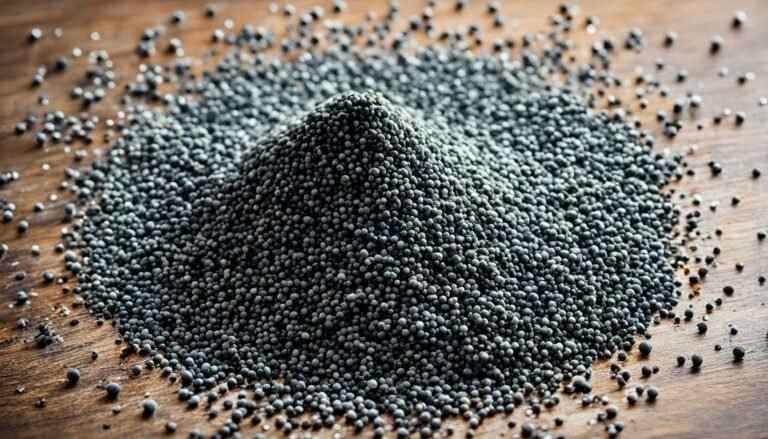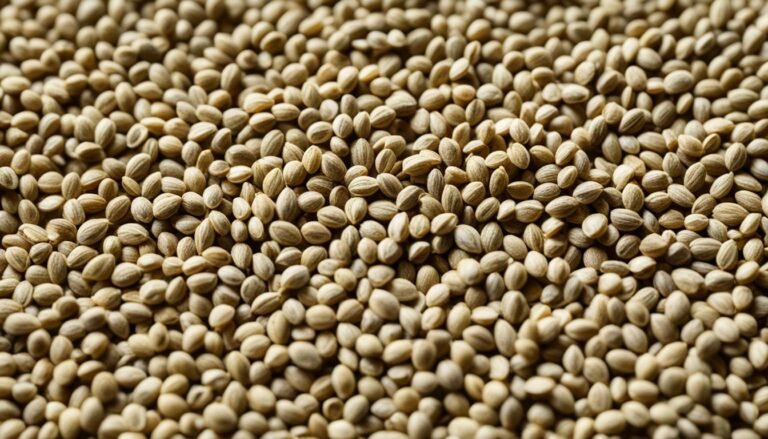Cumin Seeds: Flavorful Spice for Your Kitchen

Ground cumin is a global favorite spice, more popular than salt, pepper, or chiles. It has been used in kitchens worldwide for thousands of years. This seed brings a distinct, warming flavor to many dishes.
We’ll dive into the history, uses, and benefits of cumin seeds. This guide will help you use their aromatic power. You’ll learn to make your meals even better.
What is Cumin?
Cumin is a tiny seed shaped like a boat. It comes from the Cuminum cyminum plant, which is part of the Apiaceae family. This family includes popular herbs like parsley, caraway, and fennel. The seeds can be brownish-yellow, black, green, or white. They have been a staple in cooking for over 4,000 years. Originally, they were grown in the Nile Valley of Egypt.
A Brief History of Cumin
Cumin’s use in cooking goes far back to ancient times in the Mediterranean and Middle East.
The seeds were found in old Egyptian sites, showing they were a vital part of early meals. From there, cumin made its way to different parts of the world. It became a key flavor in many different cuisines.
Varieties and Origins of Cumin
- The most common variety of cumin is the Indian cumin, also known as “jeera,” prized for its warm, earthy aroma.
- Other cumin varieties include black cumin, Persian cumin, and Moroccan cumin, each with slightly different flavor profiles.
- Today, the top producers of cumin are India, China, and Mexico. However, it’s used widely in Latin American, Middle Eastern, North African, and South Asian cuisines.
| Cumin Variety | Origin | Flavor Profile |
|---|---|---|
| Indian Cumin (Jeera) | India | Warm, earthy aroma |
| Black Cumin | Middle East | Slightly sweeter, more complex flavor |
| Persian Cumin | Iran | Robust, pungent taste |
| Moroccan Cumin | North Africa | Subtle, slightly smoky notes |
Pronouncing Cumin
When you say the name of the spice, cumin, you might hear different pronunciations. In the US, it’s often said as “KYOO-min.” But, it’s also okay to say “KUH-min” or “KOO-min.”
In the UK, the usual way to say “cumin” is “KYOO-men.” Yet, in the US, you might hear “KOO-min” and “KUH-min” too. These ways are also right.
The many ways to say cumin come from its history. The name comes from the Latin word “cuminum.” In Latin, it would be said as “KUH-min-um.” Different cultures and languages have influenced how we say cumin today.
If you work in cooking, you’ll hear various ways to pronounce cumin. Remember, there’s no one correct way. You can say “KYOO-min,” “KUH-min,” or “KOO-min.” What matters is enjoying the flavor and smell of cumin in your dishes.

| Pronunciation | Region | Example |
|---|---|---|
| /ˈkjuː.mɪn/ | UK | KYOO-men |
| /ˈkuː.mɪn/ | US | KOO-min |
| /ˈkʌ.mɪn/ | US | KUH-min |
The Distinct Flavor of Cumin Seeds
Cumin is a unique spice known for its sharp and zesty taste. It’s a bit bitter, too. This spice adds a warm, earthy flavor to meals. You might also taste a bit of nuttiness in it.
It works well with many other spices. This is why it’s a must in lots of kitchens worldwide.
Cumin’s Unique Taste Profile
Cumin’s taste comes from a compound like the one that makes peppers hot. In India, it’s called “Jeera.” It’s used whole or ground to make dishes more flavorful and complex.
Toasting cumin seeds in a skillet before using them makes their flavor stronger. This method brings out their essential oils.
Complementary Spice Pairings
- Cardamom
- Cinnamon
- Allspice
- Clove
- Fennel
- Oregano
- Nutmeg
- Fenugreek
- Thyme
- Coriander
- Cilantro
- Sumac
- Mint
Spices like cardamom, cinnamon, or coriander work well with cumin. They make dishes flavor-rich. You often find them together in meals from different parts of the world.
Culinary Uses of Cumin Seeds
Cumin is a must in cooking in many parts of the world, like in India, the Mediterranean, the Middle East, and Mexico. It stars in curries, rides shotgun in chutneys, and makes stews sing. But be careful, its taste is mighty, so a little goes a long way.
Essential Spice in Global Cuisines
For eons, people have flavored foods with cumin seeds. They’re key in Indian curries, Mexican feasts, and North African stews. Cumin uses in cooking bring out rich, deep flavors, especially when mixed with spices like cardamom and cinnamon.
Cooking with Whole vs Ground Cumin
Whole cumin vs ground cumin – which is better? Both have their place in recipes. Toasted whole seeds add a smoky depth, while the ground form gives a quick hit of flavor. For some dishes, you might even need both.
| Whole Cumin Seeds | Ground Cumin |
|---|---|
| Retain flavor and quality for up to two years when stored properly | Should be used as soon as possible after grinding for maximum flavor |
| Add both texture and flavor to dishes | Provide a more immediate and intense cumin flavor |
| Benefit from roasting or frying before grinding to release oils and intensify flavor | Can be stored in an airtight container to maintain freshness |
No matter if you’re using cumin uses in cooking whole or ground, a little care goes a long way. Mixing it right with other spices makes for some amazing dishes.
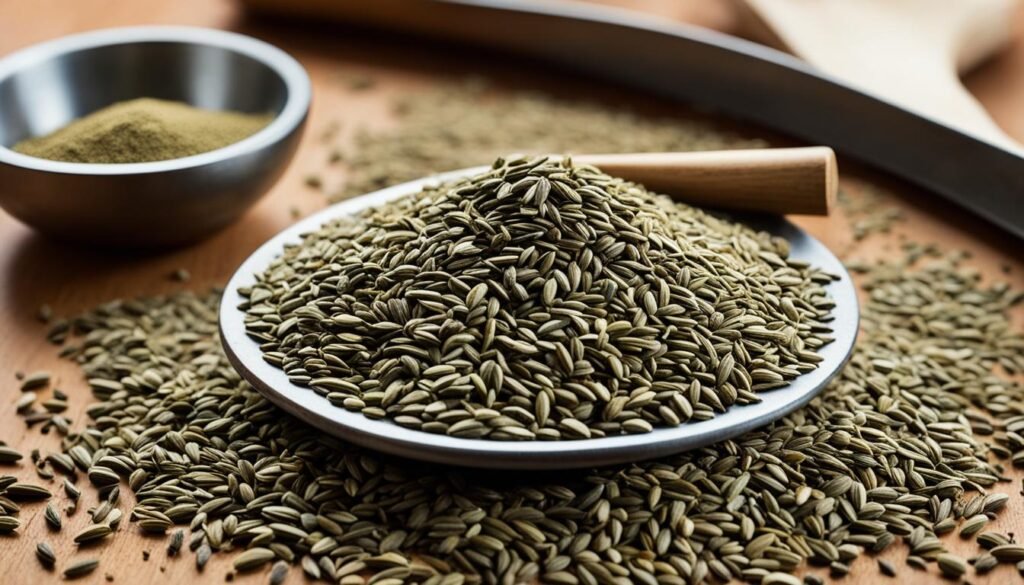
cumin seeds
Cumin seeds come from the fruit of the Cuminum cyminum plant. They are key in many foods worldwide. These seeds are small and have a ridged look. They can be light brown, dark brown, or gray.
Their flavor is warm, earthy, and a bit nutty. Cumin seeds can be whole or ground. This adds depth to lots of dishes.
India leads in cumin seed production, making 70% of the world’s supply. Syria, Turkey, the UAE, and Iran are also big producers. In 2020-2021, India hit 856,000 tons of cumin seeds.
Cumin seeds like Mediterranean-like climates. They grow well in hot, dry weather. They’re planted in fall and picked in late winter or spring. Cumin is strong but doesn’t like too much salt or heavy soil.
The taste of cumin seeds is special. They give food a rich, earthy flavor. There’s a mix of citrus and pine notes. They are perfect for dishes from India to Tex-Mex.
Shoppers can choose from whole seeds to ground powder. The quality changes by where they come from. Seeds from Iran, India/South Asia, or the Middle East each have unique flavors.
No matter where they are from, cumin seeds are tasty. They can make any homemade meal better.
Health Benefits of Cumin
Cumin seeds are not just known for their smell and taste. They also have a lot of health benefits. For centuries, people have used this spice in traditional medicine. Now, modern studies are showing its medical uses.
These seeds are full of antioxidants, vitamins, and minerals. Just a teaspoon contains 1.4 mg of iron. It gives us 17.5% of the iron we should have every day. This is very important because many people, even those in rich countries, don’t get enough iron.
Research has found that cumin could help our stomachs feel better. For example, 57 people with irritable bowel syndrome felt better after taking cumin for two weeks. Cumin helps calm the stomach because it has antispasmodic and carminative effects.
Cumin might also help with diabetes. A study showed that a cumin supplement helped with early diabetes signs in overweight people. Cumin could also help you lose weight, according to other studies.
Cumin isn’t just good for your stomach and blood sugar. It could also be good for your heart. Studies have found it boosts your “good” cholesterol and lowers bad blood fats.
While we need more research to fully grasp how cumin can help us, it’s clear this spice is beneficial. Adding cumin to your diet could improve your overall health and well-being.
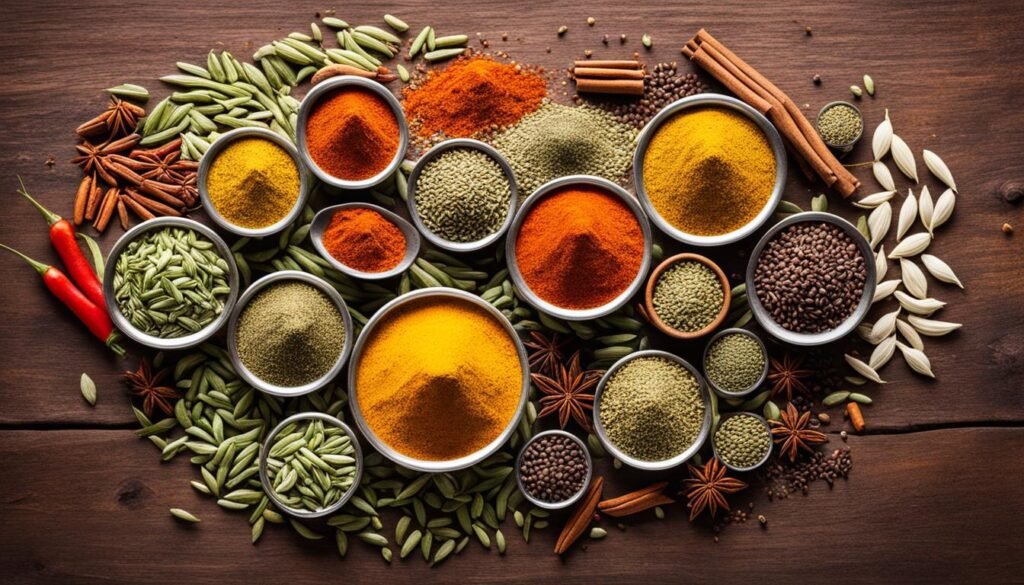
Cumin Seed Recipes
Cumin is a key flavor in many cultures’ foods, especially in Indian and Mexican dishes. It gives meals a deep, rich flavor. By using cumin in your cooking, you’re exploring tastes from around the world.
Authentic Indian Curries
In India, cumin seeds are in most curries and spice mixes, like garam masala. They add a unique earthy, nutty taste. For a true Indian flavor, add cumin to dishes like chicken tikka masala or vegetable korma.
Mexican and Tex-Mex Dishes
Cumin is a must in Mexican and Tex-Mex foods, including chili and tacos. Its smoky, bitter notes enhance these bold dishes. Sprinkle cumin into your enchiladas or chili for an authentic Mexican taste.
| Dish | Cumin Seed Quantity | Total Ingredients | Preparation Time | Serving Size |
|---|---|---|---|---|
| Chicken Tikka Masala | 2 teaspoons | 15 ingredients | 1 hour | 4 servings |
| Vegetable Korma | 1.5 teaspoons | 12 ingredients | 45 minutes | 6 servings |
| Beef Enchiladas | 3 teaspoons | 18 ingredients | 1 hour 15 minutes | 8 servings |
Cumin adds a special touch to various dishes. From Indian curries to Mexican meals, it brings flavors alive. Start using cumin in your cooking and enjoy these global tastes.
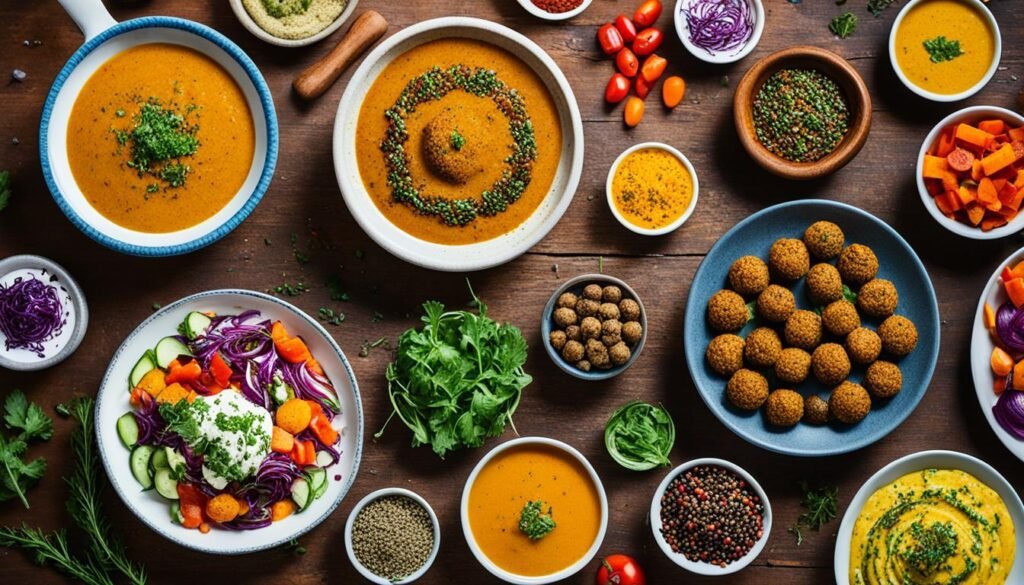
Buying and Storing Cumin Seeds
When buying and storing cumin, the details are key. Cumin has been a top spice in many meals for over 5,000 years. It’s crucial in dishes from around the world.
For top-quality cumin, choose whole, not broken, seeds that smell good and are dry. Mexico is known for its cumin harvest. Yet, India leads in cumin farming and use.
After getting your cumin, keeping it right is important. Use an airtight container for whole seeds. Keep them cool and away from light and heat. This way, they keep their strong flavor for about a year.
Remember, ground cumin doesn’t last as long as whole seeds. When the smell of whole seeds weakens, they’re losing flavor. Ground cumin fades quicker, within a few months, so replace it often.
| Storage Method | Shelf Life |
|---|---|
| Whole Cumin Seeds | Up to 1 year |
| Ground Cumin | Approximately 3 months |
For the best taste, grind whole cumin seeds when you need them. This keeps their aroma and flavor strong. It also lets you enjoy the special taste that heating the seeds in oil brings.
If you love cooking or just starting, knowing how to choose and keep cumin matters a lot. It helps you get the most out of this very versatile spice.
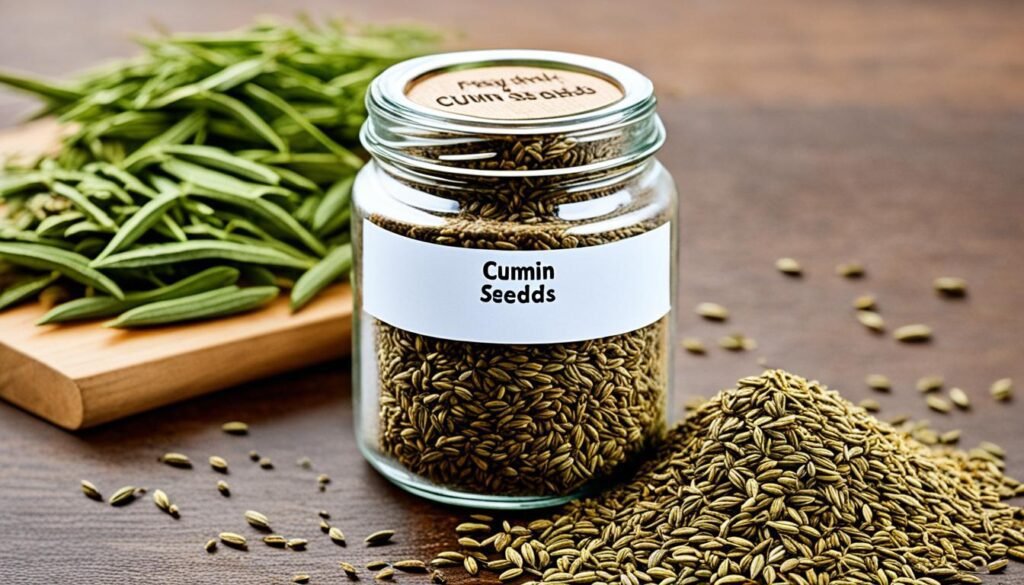
Cumin Seed Substitutes
If you don’t have cumin, there’s no need to panic. There are good substitutes that offer a similar taste. You can use ground coriander or caraway seeds. They both give off the earthy, slightly sweet flavor that cumin is famous for.
Ground coriander is a great cumin alternative. It comes from the same family as cumin, so it has similar flavors. Use only half the ground coriander as you would cumin. Then, taste your dish and add more if needed.
- Caraway seeds are also an option. They have a mild, slightly sweet, and nutty taste. Use half as much caraway seeds as you would cumin.
- Chili powder or smoked paprika can replace cumin, adding warmth and depth. Begin with a small amount. Then, add more to reach your preferred taste.
When swapping ingredients, remember the flavor might not be exactly the same. Use less of the substitute at first. Then, taste and adjust to get it how you like.
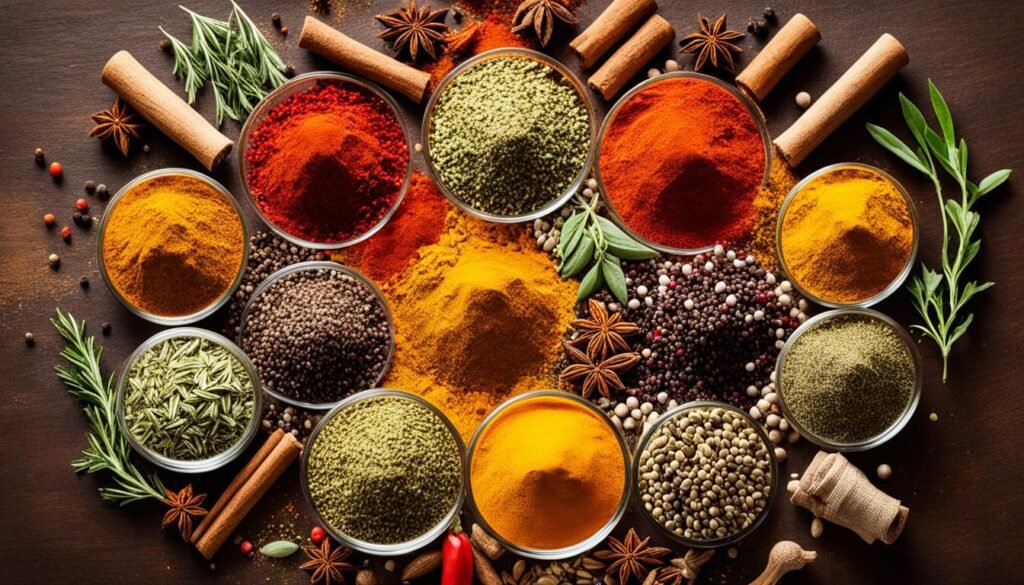
- For curry powder, use half as much as you would cumin.
- Garam masala is another option. You need half the amount as cumin.
- Taco seasoning can also work. Use about half as much as you would have cumin.
- Fennel seeds are a 1:1 swap for cumin.
The right substitute varies based on your dish and taste. Try different options to see what fits your recipe best.
Cumin in Traditional Remedies
Cumin has a long and rich history in curing illnesses. Its use dates back to ancient times. For example, the ancient Egyptians loved it so much they even buried it with pharaohs.
Today, people still use cumin in traditional medicine worldwide. Studies suggest it can help with fighting inflammation, acting as an antioxidant, and boosting digestion.
Ancient Medicinal Uses
The history of cumin in traditional medicine goes back thousands of years. Let’s look at some ways ancient people used this spice:
- In ancient Egypt, they used cumin for many things. It helped flush out water, aided digestion, and treated breathing problems.
- Chinese medicine used cumin for digestion and blood flow issues. It was also great for keeping pests away.
- In Ayurvedic medicine of India, it was a go-to for many ailments like stomach upsets and colds.
- Moroccans once relied on cumin to help with high blood pressure and diabetes.
- The Greeks and Romans also knew cumin’s worth. They used it for infections to calming nerves.
Even though we still have a lot to learn about cumin, its history shows it’s special. Its use in ancient medicine across different cultures highlights its wide range of potential benefits. The more we investigate, the more we’ll discover about this amazing spice.
Fun Facts About Cumin
Cumin isn’t just a spice – it’s a lively part of history with exciting facts. For example, cumin used to keep poultry in check. Plus, it’s in many birdseeds. The spice’s strong smell led to it being a part of perfumes. And its name means “to make one rest” in Greek. These facts show cumin is more than its taste.
Believed to start in the eastern Mediterranean, cumin has been part of cooking for 5,000 years. It’s so valued that it was used as pay in old days. Cumin has lots of antioxidants, which are good for health.
In some places, cumin helps heal wounds because it fights off germs. You can also use cumin oil to relax and reduce stress. This shows cumin’s benefits go beyond cooking.
Cumin seeds look like caraway seeds but smell different. They have a unique taste. Used since 1st century BC, cumin is key in Indian dishes. It’s the second most loved spice in India.
The rich history and versatile uses of cumin are truly captivating. From ancient times to now, cumin has lots to tell. Its role in cooking, healing, and more keeps us curious.
Conclusion
Cumin seeds are not just any spice; they bring rich flavor and history. People have used them for thousands of years, from ancient Egypt to today’s global cooking. Cumin is key for making curries tastier, Tex-Mex dishes pop, and enjoying the benefits of cumin at home.
Cumin seed uses go beyond adding taste. They might help with digestion, lower inflammation, and strengthen your immune system. With its unique mix of flavors – earthy, nutty, and a hint of citrus – cumin pairs well with many foods. This makes your meals not just tasty but also balanced.
By using cumin in your recipes, you can experience the spice’s many benefits. Add it whole or ground to your dishes for a surprising twist. Let the variety and history of cumin enrich your cooking and health. Make cumin a part of your kitchen to enjoy its magic for years.
FAQ
What is cumin?
Cumin is a seed from the Cuminum cyminum plant. It’s part of the apiaceae family, along with plants like parsley. The cumin seed comes from the Nile valley in Egypt. Today, it’s used all over the world in cooking.
What are the different varieties of cumin?
Many types of cumin exist. The most well-known is the Indian cumin. It’s called jeera and has a delightful, earthy smell.
How do you pronounce cumin?
“KYOO-min” is the most used way to say it. But, “KUH-min” and “KOO-min” are also right.
What does cumin taste like?
Cumin’s taste is sharp and zesty with a bit of bitterness. It also has earthy and nutty hints. A little like fennel, it has a cooling taste.
What spices pair well with cumin?
Cumin goes well with many spices. This includes cardamom, cinnamon, thyme, and chili. It also mixes perfectly with herbs like cilantro and mint.
What are the common culinary uses of cumin?
Cumin is found in many cuisines, like Indian and Mexican. It’s used in curries, soups, and chili. You’ll also see it in stews and barbecue sauces.
How should cumin be stored?
Keep whole cumin seeds in a dry, dark spot in a sealed container. For ground cumin, use it within 6 months. This keeps its flavor fresh.
What are some good substitutes for cumin?
If you’re out of cumin, try ground coriander or caraway seeds. Chili powder or smoked paprika work too, adding warmth and flavor.
What are the potential health benefits of cumin?
Cumin is good for digestion and might help with inflammation. It may also offer benefits for diabetes. But, more research on its health effects is necessary.
What are some interesting facts about cumin?
Ancient people thought cumin could keep birds nearby. It’s an ingredient in birdseed. Its name comes from a Greek word that implies it makes you rest.


